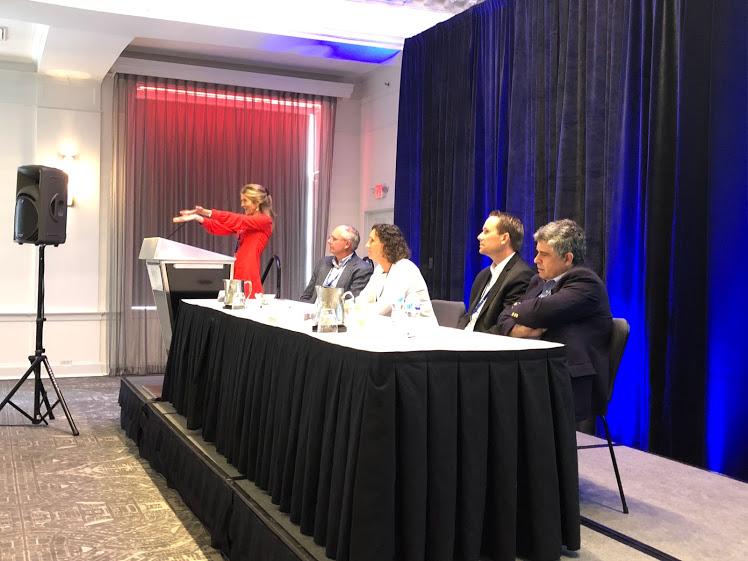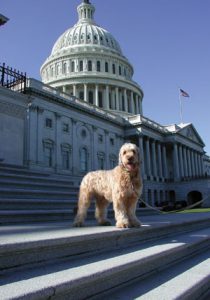Dr. Jean Bennett: ‘Seeing the Light with Retinal Gene Therapy’

Dr. Jean Bennett giving her presentation as part of the LCA Family Conference session called “One Disease, Many Approaches.”
Known as a pioneer in gene therapy, Jean Bennett, MD, PhD, surveyed her audience of patients and families living with Leber congenital amaurosis and declared: “YOU are all the pioneers!”
Dr. Bennett, addressing more than 80 people from 15 states and Mexico at the Sofia Sees Hope second LCA Family Conference, characterized the meeting as a great place to reach out to patients to participate in clinical trials. Researchers normally recruit study patients through advertising.
Along with families living with LCA and other inherited retinal diseases (IRDs), people attending the summer conference in Philadelphia included patient advocates, doctors, researchers and biotechnology industry leaders.
Dr. Bennett is Professor of Ophthalmology at the Center for Advanced Retinal and Ocular Therapeutics and the F.M. Kirby Center for Molecular Ophthalmology at the Perelman School of Medicine, University of Pennsylvania. She gave her presentation as part of a conference session called “One Disease, Many Approaches.”
Viral Vectors Key
Dr. Bennett was one of the first investigators to use viral vectors, in which a virus is used as a vector or carrier that is genetically engineered to deliver the gene to specific cells in the retina.
She emphasized that LUXTURNA™, the breakthrough genetic treatment she and her colleagues developed at Children’s Hospital of Philadelphia (CHOP) and Spark Therapeutics, began with the successful treatment of a special being: Lancelot, the first in a line of Briard herding dogs, who helped drive research to bring to market gene therapy that improved vision by focusing on a particular mutated gene.
Dr. Bennett and her colleagues studied Lancelot and the other dogs after learning that a veterinary ophthalmologist had identified the gene which, when mutated, led to blindness in Swedish Briard dogs.
The research dogs received an engineered virus delivering the human RPE65 gene, a gene that, when mutated, causes LCA RPE65, also known as LCA2, one of the more than 25 forms of LCA. Doctors delivered the drug by subretinal injection through a needle the size of an eyelash. The treatment works by encoding an enzyme that converts light into electrical signals interpreted by the brain.
Dr. Bennett’s presentation, “Seeing the Light with Retinal Gene Therapy: From Fantasy to Reality,” features a photograph of Lancelot wearing glasses and perusing his article in Nature Genetics magazine.
Lancelot accompanied her on her frequent Congressional visits to lobby for more research funding. Dr. Bennett said Lancelot’s distant cousin, Venus, and later her pups, Mercury and Saturn, also successfully received the treatment.
According to an article in the Philadelphia Inquirer, “Before the treatment, Venus preferred to crouch in a corner for fear of bumping into objects. But after the treatment, it was clear that Venus and the other dogs were able to see. They could easily navigate obstacle courses set up by researchers. Venus was a new dog, eager to walk around and explore grass, birds, and squirrels for the first time.”
Dr. Bennett, noting Venus’ recent passing, said, “She died of old age. Still seeing.” The headline on Venus’ July 16 obituary in the Philadelphia Inquirer read: “Main Line dog, used to help cure blindness in humans, dies at 12.”
First Dogs, Then People
The trials on dogs led to successful treatment in people beginning in 2007 after Dr. Bennett and her husband, Dr. Albert Maguire, teamed up with Dr. Katherine High to run human clinical trials. Christian Guardino, an America’s Got Talent Golden Buzzer award winner from Long Island, received treatment at age 13 during the trials, as well as others, including Cleveland-area resident Tami Morehouse, who at age 44 at the time, was the oldest participant in the trial.
LUXTURNA, approved by the U.S. Food and Drug Administration in December 2017, is the first and only approved gene therapy for inherited disease in the United States and Europe. The breakthrough medicine unlocked the potential of the Human Genome Project to provide options for people when there were none.
The treatment fostered pioneering changes in medical practices, motivating ophthalmologists and insurers to do genetic testing, and it created a path for genetic treatments to blindness.
Dr. Bennett said she is thankful for the clinical trial participants, team members, regulatory bodies, advisors and the dogs who helped along the way.
Genetic research still faces a host of challenges, including the rapid degeneration of cells needed for gene therapy to work and too long a span of time to get results for diseases that progress very slowly.
More patients have been treated with LUXTURNA post-FDA approval than the 29 who received treatment during the trials. In the first few months after approval, more than a dozen people underwent treatment at CHOP, one of the 10 approved treatment centers in the United States. Also, the first patient in Paris received the gene therapy in January.
Successes with the New Treatment
- Jason Comander, MD, PhD, and his team from Massachusetts Eye and Ear made history as the first to administer the approved gene therapy. Thirteen-year-old Jack Hogan underwent surgery March 20, 2018. He told his mom that his best day ever after surgery came when he could read the whiteboard in class without a visual aid.
- Several days later in March 2018, Dr. Audina Berracol performed the surgery on 9-year-old Creed Pettit of Mount Dora, Fla., at Bascom Palmer Eye Institute in Miami. Creed no longer needed help keeping the handlebars on his bike steady. Later that summer he saw his very first rainbow.
- Dr. Maguire, who created LUXTURNA with Dr. Bennett, performed the surgery at CHOP in July 2018 on 8-year-old Hannah Reif of Maple Glen, Penn. Hannah saw her first star seven days after surgery on her left eye. She underwent surgery for her right eye six days later.
- Aaron Nigel, MD, PhD, performed the surgery on 6-year-old Monroe Le of San Diego, Calif., in August 2018 at Children’s Hospital of Los Angeles. Her mom videotaped her running around outside in the dark yelling, “I can see! I can see!”
 Before LUXTURNA, no path existed for pediatric drug development in ophthalmology. In a slide titled “Retinal Gene Therapy is Alive & Well,” Dr. Bennett said more than 700 people are enrolled in clinical trials at more than 30 sites.
Before LUXTURNA, no path existed for pediatric drug development in ophthalmology. In a slide titled “Retinal Gene Therapy is Alive & Well,” Dr. Bennett said more than 700 people are enrolled in clinical trials at more than 30 sites.
“We obtained approval and paved the way for all future pediatric gene therapy trials,” she said.
As this genetic superhero said at the beginning of her presentation – that the audience members are the pioneers – Dr. Bennett looked out at the gathering as she ended her talk and declared: “It is the families who are really the heroes.”

